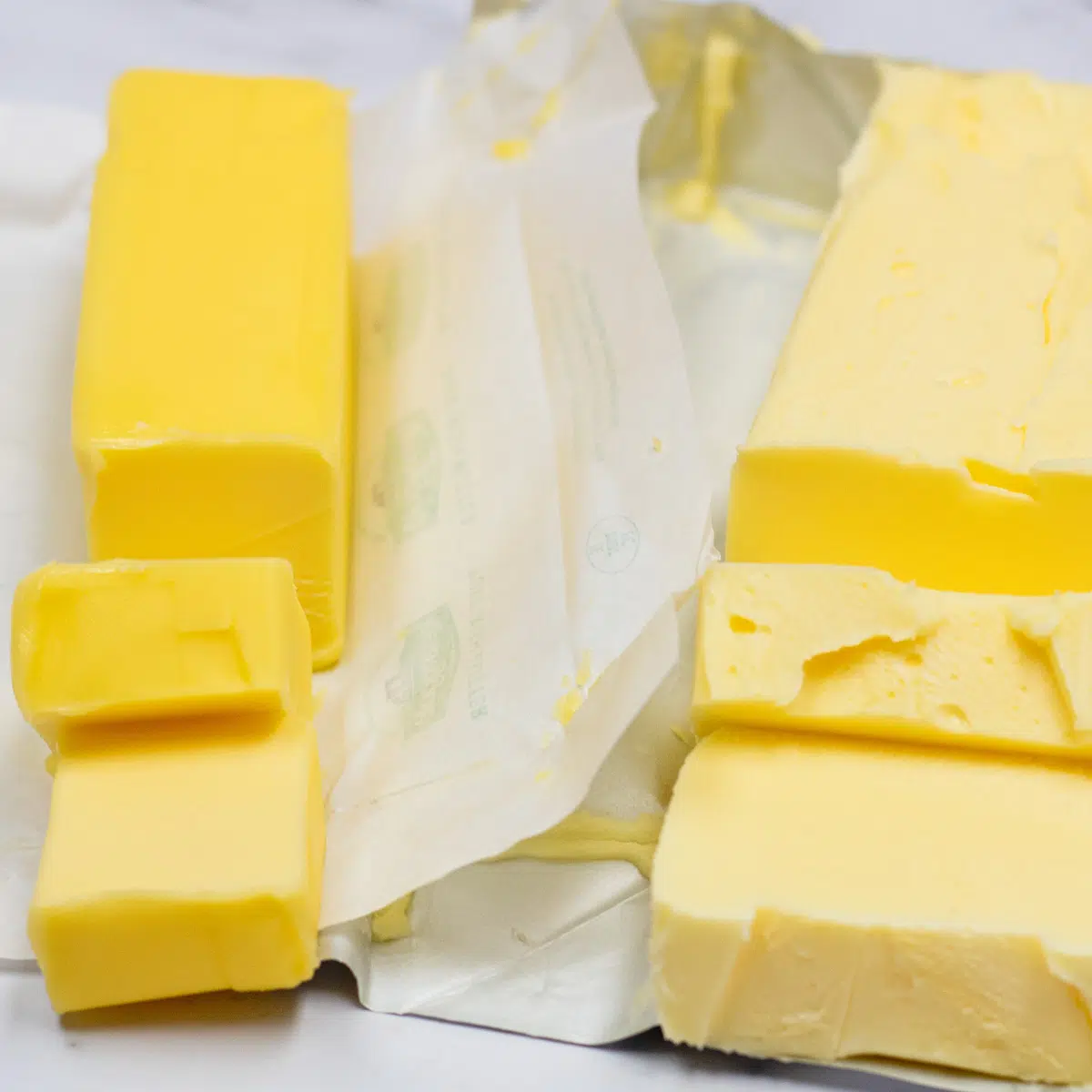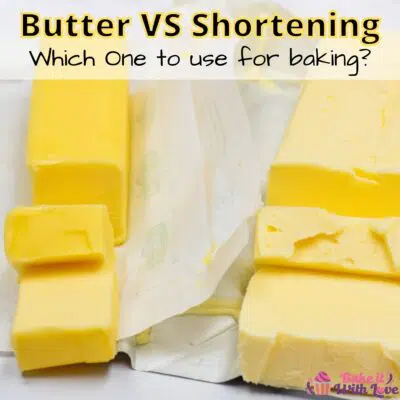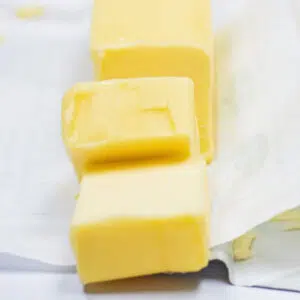Butter vs. shortening in baking is a wonderful topic to explore that will also help you become a better baker overall. Both butter and shortening are a key ingredient in any baker's arsenal, and when it comes to which is better, the answer isn't so simple. Read about it to help you decide if butter or shortening is best for your recipe.
Experiment with using butter and shortening with some of my tasty recipes, like my peanut butter cookies, cherry pie bars, or Irish apple cake.

Jump to:
Butter and shortening are the two most commonly used fats in baking today, but which is best? This is a frequently asked question that has a not-so-straightforward answer. It depends. Yikes, sorry!
There are quite a few factors to consider when deciding which option is best for your particular recipe. After that, it all comes down to personal preference.
Is Butter Or Shortening Better For Baking
Achieving a certain taste, texture, and structure for baked goods all comes down to the type of fat you choose to use. Surprisingly, it actually can vary on what kind of fat is considered to be the best.
Fat can refer to oil, shortening, margarine, butter, or plain old lard. Butter and shortening are the most common types of fat used in baking, so we will focus on those for the purpose of this article.
Both butter and shortening have their place in the baking world. In many recipes, you can even substitute one for the other.
The decision to use butter or shortening depends on your desired outcome in structure, texture, and taste.
What Is Shortening
Shortening is defined as 'any fat that is solid or semi-solid at room temperature.' Just imagine that can of Crisco on the pantry shelf that maintains its perfect solid form year-round (we all have it!)
If you didn't know, shortening is actually made from plants. Specifically, edible oils that have been extracted from olives, sunflowers, and soybeans. Why is it solid and not liquid if it comes from edible oils? That is the result of a process called hydrogenation.
There is a more complex scientific explanation of hydrogenation, but here is a simple explanation for the purpose of understanding shortening:
Vegetable oil (from olives, sunflowers, or soybeans) goes through a process that turns it from unsaturated fat (in the liquid state) to saturated fat (in the solid state). Thus, shortening = hydrogenated vegetable oil.
Why does this matter
- Shortening is 100% fat with zero water content.
- Shortening has a high melting point.
The two elements of shortening are the key to understanding how and when to use it in baking.
First, let's look at what butter is. Then, we can compare the two different fats used in your favorite baked treats.
What Is Butter
Butter is a dairy product that is made from churning any variety of milk. Unlike shortening, which is 100% fat, butter is only 80% fat in total.
The other 20% is about 16-18% water and about 2-4% milk solids, meaning butter has water content where shortening does not.
As a result, the added water content in butter affects its melting point. Because butter is only 80% fat, it will melt at lower temperatures and more quickly than shortening.
Difference Between Butter & Shortening
The fat and water content of butter and shortening are what create the differences in taste, texture, and even structure when baking with these two ingredients.
Generally speaking, shortening provides baked goods that are flakier and crumblier in texture. This is due to the lower water content.
As a result of the high melting point, treats like cookies will be thicker and rounder (since they won't melt in the oven).
On the other hand, treats baked with butter result in a thinner or flatter structure since the butter melts and spreads faster.
However, because of the water content in butter, your cookies will be chewier, and other baked goods will be moister.
Baking With Butter And Shortening
These are the simple rules of when to choose shortening or butter. These rules vary slightly from recipe to recipe, though. Here are the quick notes for baking with butter vs shortening:
Keep reading to see how butter and shortening impact all your favorite baked goods. This will help you determine which one you prefer or when you can substitute one for the other.
>>>See All Of My Recipes Here!<<<
Cookies
Cookies can be made with either butter or shortening! This means that which one you choose is completely up to you and your personal preference.
Using butter to make cookies will cause them to melt and spread in the oven. As a result, your cookie will be flatter but wonderfully chewy in texture. (Check out my post on how to prevent cookies from spreading to solve this!)
Since shortening has a higher melting point (because it contains no water), the cookies won't spread as much and will be thicker and more round. However, they will be more crumbly and not as chewy.
When it comes to flavor, butter is very rich. Shortening, on the other hand, is considered neutral or flavorless.
It can easily be intimidating to have to decide to make cookies with butter or shortening. However, you can easily alter any cookie recipe to use both options!
You'll get all of the benefits of both shortening and butter. Your cookies will be moist, chewy, thick, and flavorful.
If you want to try this out, simply use equal amounts of both butter and shortening in your recipe (but make sure the total amount is what the recipe calls for!)
Personally, I think there are no better cookies than ones made from butter. However, I can easily see the benefits of using both butter and shortening (and even do it myself sometimes!)
Pie Crusts
Many pie crust recipes call for shortening. This is because the perfect pie crust is often described as 'nice and flaky.' Using all shortening will give you exactly that - a nice flaky crust.
When using only butter, the crust around the outside edges of the pie will be more golden, and the bottom of the crust will often be moist and denser.
The pie filling is usually the star of the show, so taste may not be as important when it comes to the crust. A crust made with shortening will be more bland, while a butter crust will provide a rich, buttery flavor.
Bread
The use of butter and shortening when baking bread is more complicated than other baked goods. Unless your bread recipe specifically calls for shortening, it is best to use butter, especially for yeast bread.
Water helps yeast rise; therefore, the moisture content in butter is essential to achieving the bread's desired rise, structure, and texture. You must adjust the rising time if you choose to substitute shortening for butter in yeast bread.
This will vary depending on the recipe; it's best to research what changes are needed for a specific recipe.
Quick bread recipes, or non-rising bread, are easier to modify. The general rules of baking with shortening and butter still apply.
While the moisture content is not necessary for allowing the bread to rise, it is still necessary for moist bread.
Using butter for quick bread like banana bread will result in nice, moist bread. Using shortening in these types of bread will result in drier and often denser bread.
As always, remember to consider flavor. There's nothing quite like the buttery undertones of banana bread.
In addition, yeast bread that calls for salted butter can turn out quite bland if the butter is replaced with shortening.
Biscuits
Biscuits are the one baked good where the word 'flaky' is associated with butter rather than shortening.
If you imagine a biscuit with flaky layers and a golden top, butter is what you want. The water content in butter creates steam that creates little air pockets while baking.
This provides a nice rise in the biscuit and adds moisture to the dough. The result? Biscuits that are both flaky and moist!
In contrast, biscuits made with shortening will be crumblier and drier. Without the steam to create the natural rise from the air pockets, these biscuits will also be denser. The final texture may remind you more of an English scone.
Cakes
Unlike cookies and biscuits, you won't see an immediate difference in a cake baked with butter vs. shortening. They tend to rise about the same.
Differences in using shortening or butter are noticed more in the texture and sometimes flavor of the cake. A simple white or yellow cake made with shortening will give you a light and fluffy cake.
However, a simple cake like this may lose some of its flavor when made with shortening.
With a more complex flavored cake, like a carrot cake or a rich chocolate cake, substituting shortening for butter will not impact the flavor. In fact, the lack of flavor in the shortening is sometimes better so that the other flavors can come through.
Frosting
One of the biggest factors in deciding whether to use butter vs shortening for your frosting is based on what your frosting will be used for - and where it will be used.
Shortening has a high melting point, meaning it only melts at high heat. Therefore, it will hold its shape in many different environments. Butter, on the other hand, will soften or even melt.
Shortening is the best option if you are decorating a cake that will be sitting on a table or outside for a long time. It will maintain its structure without any need for refrigeration.
However, if you decorate a cake with buttercream frosting and leave it sitting outside of the fridge for any length of time - your frosting will melt.
If you don't have to worry about frosting holding up under heat, the taste of good buttercream frosting is hard to beat!
💭 Tips For Choosing Between Butter and Shortening
Choosing between butter and shortening can be difficult. I put together some easy tips to help you decide what to use.
- Flavor: Shortening has a very neutral flavor, which is great for when you want to let the other flavors in your dish shine. On the other hand, butter is loaded with a rich, distinct flavor that everyone loves.
- Texture: Since butter contains water, it has a lower melting point than shortening doesn't. As a result, using butter will give you baked goods that are softer and more tender. Using shortening will create things that are firmer with a flaky texture.
- Temperature: Shortening is easy to use since it is always solid. Butter, however, needs to be warmed to room temperature before using it so that it can be mixed together properly.
- Recipe Adaptation: For the most part, these two options can easily be interchanged with one another. However, the texture of your baked goods may be affected (as well as the flavor).
- Combination: Feel free to experiment with using both butter and shortening! Combining the two can give you the benefits of a buttery flavor and the structure from shortening.
Do you love a recipe you tried? Please leave a 5-star 🌟rating in the recipe card below and/or a review in the comments section further down the page.
Stay in touch with me through social media @ Pinterest, Facebook, Instagram, or Twitter! Subscribe to the newsletter today (no spam, I promise)! Don't forget to tag me when you try one of my recipes!
📖 Recipe Card
Butter vs Shortening: Everything You Need To Kow + How To Make Homemade Butter!
Ingredients
- 2 cups heavy cream
- 1 pinch salt (optional)
(Note: 2x or 3x only changes the ingredient list)
Instructions
- Pour your 2 cups heavy cream into a food processor or blender.
- Mix the cream on high speed until it comes together into a butter consistency that is separated from the liquid buttermilk.
- Strain the buttermilk from the butter, then rinse the butter in cool tap water to finish removing the buttermilk.
- Add the optional 1 pinch salt and mix it in. Transfer your homemade butter into a plastic storage container and use like store-bought.
Notes
- Yields ½ cup butter = 1 stick or 8 servings of 1 tablespoon each.
- Strain the liquid into a jar to save the 1 cup buttermilk that is also produced.
- Keep your DIY butter refrigerated between use.



Joan Ledbetter says
This was very interesting . My peanut butter cut out cookies ask for 1/2 cp of shortening as well as butter. All is good , but my question is I was told yo put the shortening in the fridge it will last longer and take the required amt out to be room temp of course. My fridge went to 50 degrees over night , would that be ok to use at room temp as it really is usually in the cubbard anyway ? My fridge is back up and ok now . Better safe then sorry of course I tossed out all the eggs creams etc! Kept the crisco .
Angela @ BakeItWithLove.com says
I would personally go ahead and save the Crisco for use, despite the temperature change (since I usually store it at room temp anyway). Use your best judgment and make sure that there are no clearly visible signs of bad texture, smell, etc.